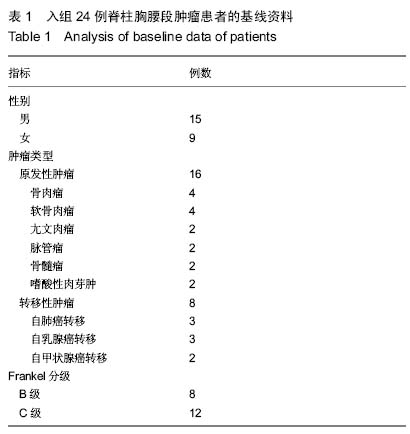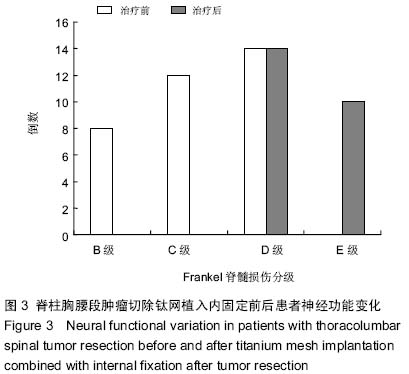| [1] 王宏亮,干阜生,曹杰,等.后入路脊椎整块切除+经椎弓根内固定重建脊椎稳定性治疗胸椎肿瘤[J].临床骨科杂志,2010,13(3): 256-259.
[2] 施力,邝光志,廖琪,等.椎弓根螺钉对胸腰段椎管内肿瘤术后脊柱稳定性的作用[J].中国微侵袭神经外科杂志,2013,18(7): 316-317.
[3] 朱天亮,王仁忠.胸腰段椎管内肿瘤的诊断及手术治疗[J].中国现代医学杂志,2005,15(10):1537-1538.
[4] 高宏阳,申勇,刘英娇,等.胸腰段髓内神经鞘瘤继发出血1例报告[J].中国脊柱脊髓杂志,2013,23(8):766-768.
[5] 罗永春,秦家振,戴宜武,等.胸腰段椎管内肿瘤误诊为腰椎间盘突出症23例分析[J].中国医师进修杂志,2009,32(17):75-76.
[6] Cicciù M, Herford AS, Stoffella E,et al.Protein-Signaled Guided Bone Regeneration Using Titanium Mesh and Rh-BMP2 in Oral Surgery: A Case Report Involving Left Mandibular Reconstruction after Tumor Resection.Open Dent J. 2012;6:51-55.
[7] Jovanovic SA, Hunt DR, Bernard GW, et al.Bone reconstruction following implantation of rhBMP-2 and guided bone regeneration in canine alveolar ridge defects.Clin Oral Implants Res. 2007; 18(2):224-230.
[8] 黄卫民,阿不都乃比•艾力,李磊,等.胸腰段脊柱前路手术并发症及防治[J].中国矫形外科杂志,2012,20(14):1309-1310.
[9] Dai LY, Jiang LS, Jiang SD.Anterior-only stabilization using plating with bone structural autograft versus titanium mesh cages for two- or three-column thoracolumbar burst fractures: a prospective randomized study.Spine (Phila Pa 1976). 2009;34(14):1429-1435.
[10] 朱永坚,沈宏,张建民,等.铣刀椎板成形加椎管重建术在胸腰段椎管内肿瘤手术中的应用[J].浙江创伤外科,2010,15(2): 133-135.
[11] 范少地,钟桂午,闫自强,等.胸腰段脊髓肿瘤切除后重建脊柱后柱稳定性的临床观察[J].中国临床康复,2002,6(22):3400-3401.
[12] 李伟.胸腰段椎管内肿瘤误诊为腰椎间盘突出症23例临床分析[J].现代诊断与治疗,2013,(10):2271-2271.
[13] Kang CN, Cho JL, Suh SP,et al.Anterior operation for unstable thoracolumbar and lumbar burst fractures: tricortical autogenous iliac bone versus titanium mesh cage.J Spinal Disord Tech. 2013;26(7):E265-271.
[14] 徐建广,周蔚,孔维清,等.后路Ⅰ期经椎弓根全椎体切除结合无瘤技术治疗胸椎转移性肿瘤[C].//第7届长征脊柱外科学术论坛论文集.2011:172-173.
[15] Korovessis P, Petsinis G, Koureas G,et al.Anterior surgery with insertion of titanium mesh cage and posterior instrumented fusion performed sequentially on the same day under one anesthesia for septic spondylitis of thoracolumbar spine: is the use of titanium mesh cages safe?Spine (Phila Pa 1976). 2006;31(9):1014-1019.
[16] 彭涛,徐宏,周增俊,等.切开椎板钛网固定椎管重建在胸腰椎椎管内病变手术中的应用[J].中国临床神经外科杂志,2009,14(12): 718-719,722.
[17] 杨强,李建民,杨志平,等.全脊椎整块切除术治疗胸腰椎肿瘤及稳定性重建结果[J].中华肿瘤杂志,2013,35(3):225-230.
[18] 张卫,晏怡果,王文军,等.前后路联合一期全椎体切除脊柱重建治疗胸腰椎恶性肿瘤[J].中国矫形外科杂志,2006,14(21): 1617-1619.
[19] 宋君涛,郭志坤.骨科修复重建中医用钛网的应用[J].中国组织工程研究,2013,(12):2233-2240.
[20] 章凯,尹庆水,夏虹,等.钛网联合前路内固定系统在12例胸腰椎肿瘤患者中的应用[J].第三军医大学学报,2005,27(6):578-578.
[21] Korovessis P, Repantis T, Iliopoulos P, et al.Beneficial influence of titanium mesh cage on infection healing and spinal reconstruction in hematogenous septic spondylitis: a retrospective analysis of surgical outcome of twenty-five consecutive cases and review of literature.Spine (Phila Pa 1976). 2008; 33(21):E759-767.
[22] 杨强,李建民,杨志平,等.胸腰椎肿瘤全脊椎切除术后的稳定性重建及其并发症[J].中华骨科杂志,2011,31(6):658-663.
[23] 董健,周晓岗,李熙雷,等.一期后路全脊椎整块切除(en bloc)治疗腰椎恶性肿瘤[C].//第三届全国中西医结合骨科微创学术交流会论文集.2013:108-108.
[24] 李伟栩,叶招明,黄鑫,等.全脊椎整块切除治疗胸腰椎软骨肉瘤[J].中华骨科杂志,2012,32(11):996-1000.
[25] 张叶松,王文军,沈合群,等.钛网融合器在胸腰椎椎体重建中的临床应用[J].医学临床研究,2004,21(9):1047-1048.
[26] 王旭,李永民,李颉,等.钛网及同种异体骨联合植入术在胸腰椎结核术中的应用价值[J].中国骨肿瘤骨病,2010,9(1):43-45.
[27] Wang B, Lv G, Liu W, Cheng I.Anterior radical debridement and reconstruction using titanium mesh cage for the surgical treatment of thoracic and thoracolumbar spinal tuberculosis: minimium five-year follow-up.Turk Neurosurg. 2011;21(4): 575-581.
[28] 栗向东,王臻,郭征,等.后路I期全脊椎整块切除治疗胸腰椎原发和转移性肿瘤的疗效分析[J].中国骨与关节杂志,2014,(5): 336-340.
[29] Christodoulou AG, Givissis P, Karataglis D, et al.Treatment of tuberculous spondylitis with anterior stabilization and titanium cage.Clin Orthop Relat Res. 2006;444:60-65.
[30] O'Shaughnessy BA, Ondra SL, Ganju A,et al.Anterior thoracic spine reconstruction using a titanium mesh cage and pedicled rib flap.Spine (Phila Pa 1976). 2006;31(16):1820-1827.
[31] 杜远立.钛网联合前路内固定系统在胸椎肿瘤手术中的应用[C].//第12届全国骨肿瘤学术会议论文集.2011:112-113.
[32] 章凯,吴文,尹庆水,等.钛网联合前路内固定系统对重建胸腰椎肿瘤患者脊柱稳定性及神经功能恢复的作用[J].中国临床康复,2004,8(35):8134-8135.
[33] 王朝鲁,杨有赓,孙红辉,等.胸腰段椎体肿瘤的外科治疗[J].四川医学,2006,27(12):1297-1298.
[34] 王文军,曹盛俊,周江南等.钛网融合器在胸腰椎前路重建术中的应用[J].脊柱外科杂志,2004,2(1):40-42.
[35] 楚戈,张宏其,唐明星,等.钛网及植骨融合修复中重度脊柱后凸畸形[J].中国组织工程研究,2013,(22):4034-4041.
[36] 吴宏增.脊柱胸腰段肿瘤切除钛网植入结合五种内固定的生物力学试验研究[D].河北医科大学,2010.
[37] 白云深,孙红辉,田秀范,等.TSRH器械加钛网治疗老年胸腰椎椎体肿瘤[J].中国老年学杂志,2006,26(6):768-769.
[38] 尹占民,魏开斌,王军,等.侧前方胸膜外和腹膜外减压治疗胸腰段脊柱病变(附9例介绍)[J].中国矫形外科杂志,2006,14(12): 897,917.
[39] 陈鑫营,陈子华.前后路联合全椎体切除脊柱重建治疗胸腰段椎体肿瘤[J].中国社区医师(医学专业),2010,12(30):70-71.
[40] 黄爱军,彭建强,张旗,等.胸腰段椎体缺损的修复重建[J].医学综述,2008,14(2):258-260.
[41] 胡永成,夏群,纪经涛,等.同体位一期前后联合入路脊柱肿瘤切除术[J].中华骨科杂志,2008,28(2):89-95.
|


.jpg)
.jpg)